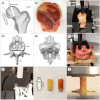Selected mechanical properties of human cancellous bone subjected to different treatments: short-term immersion in physiological saline and acetone treatment with subsequent immersion in physiological saline
- PMID: 35933396
- PMCID: PMC9357305
- DOI: 10.1186/s13018-022-03265-4
Selected mechanical properties of human cancellous bone subjected to different treatments: short-term immersion in physiological saline and acetone treatment with subsequent immersion in physiological saline
Abstract
Background: Physiological saline (0.9% NaCl) and acetone are extensively used for storage (as well as hydration) and removal of bone marrow, respectively, of cancellous bone during preparation and mechanical testing. Our study aimed to investigate the mechanical properties of cancellous bone subjected to short-term immersion in saline and acetone treatment with subsequent immersion in saline.
Methods: Cylindrical samples (Ø6 × 12 mm) were harvested from three positions (left, middle, and right) of 1 thoracic vertebral body, 19 lumbar vertebral bodies, and 5 sacral bones, as well as from 9 femoral heads. All samples were divided into two groups according to the different treatments, (i) samples from the left and middle sides were immersed in saline at 4℃ for 43 h (saline-immersed group, n = 48); (ii) samples from the respective right side were treated with a combination of acetone and ultrasonic bath (4 h), air-dried at room temperature (21℃, 15 h), and then immersed in saline at room temperature (21℃, 24 h) (acetone and saline-treated group, n = 38). All samples were subjected, both before and after treatment, to a non-destructive compression test with a strain of 0.45%, and finally destructive tests with a strain of 50%. Actual density (ρact), initial modulus (E0), maximum stress (σmax), energy absorption (W), and plateau stress (σp) were calculated as evaluation indicators.
Results: Based on visual observation, a combination of acetone and ultrasonic bath for 4 h failed to completely remove bone marrow from cancellous bone samples. The mean values of ρact, σmax, W, and σp were significantly higher in the femoral head than in the spine. There was no significant difference in E0 between non-treated and saline-immersed samples (non-treated 63.98 ± 20.23 vs. saline-immersed 66.29 ± 20.61, p = 0.132). The average E0 of acetone and saline-treated samples was significantly higher than that of non-treated ones (non-treated 62.17 ± 21.08 vs. acetone and saline-treated 74.97 ± 23.98, p = 0.043).
Conclusion: Short-term storage in physiological saline is an appropriate choice and has no effect on the E0 of cancellous bone. Treatment of cancellous bone with acetone resulted in changes in mechanical properties that could not be reversed by subsequent immersion in physiological saline.
Keywords: Acetone; Bone marrow; Cancellous bone; Mechanical properties; Physiological saline.
© 2022. The Author(s).
Conflict of interest statement
The authors declare no competing interests.
Figures







Similar articles
-
Assessment of the Defatting Efficacy of Mechanical and Chemical Treatment for Allograft Cancellous Bone and Its Effects on Biomechanics Properties of Bone.Orthop Surg. 2020 Apr;12(2):617-630. doi: 10.1111/os.12639. Epub 2020 Mar 18. Orthop Surg. 2020. PMID: 32189444 Free PMC article.
-
The effects of density and test conditions on measured compression and shear strength of cancellous bone from the lumbar vertebrae of ewes.Med Eng Phys. 1997 Jul;19(5):464-74. doi: 10.1016/s1350-4533(97)00001-5. Med Eng Phys. 1997. PMID: 9338887
-
Influence of the fixation technique on the mechanical properties of human cancellous bone of the femoral head.Clin Biomech (Bristol). 2021 Feb;82:105280. doi: 10.1016/j.clinbiomech.2021.105280. Epub 2021 Jan 24. Clin Biomech (Bristol). 2021. PMID: 33582564
-
Assessment of the efficiency of different chemical treatments and ultrasonic cleaning for defatting of cancellous bone samples.Cell Tissue Bank. 2022 Sep;23(3):499-510. doi: 10.1007/s10561-021-09969-x. Epub 2021 Oct 29. Cell Tissue Bank. 2022. PMID: 34714441 Free PMC article.
-
Distribution of Young's modulus at various sampling points in a human lumbar spine vertebral body.Spine J. 2020 Nov;20(11):1861-1875. doi: 10.1016/j.spinee.2020.06.013. Epub 2020 Jun 25. Spine J. 2020. PMID: 32592901
Cited by
-
Effect of hot water maceration, rehydration, and soft tissue presence on 3D geometry of bone.Forensic Sci Med Pathol. 2025 Mar;21(1):98-106. doi: 10.1007/s12024-024-00845-0. Epub 2024 Jun 15. Forensic Sci Med Pathol. 2025. PMID: 38878109 Free PMC article.
-
Comprehensive characterization of cell and tissue responses toward high hydrostatic pressure treatment: Molecular feedback and structural integrity in bone graft processing.J Tissue Eng. 2025 Jun 28;16:20417314251337193. doi: 10.1177/20417314251337193. eCollection 2025 Jan-Dec. J Tissue Eng. 2025. PMID: 40584833 Free PMC article.
-
An additively manufactured model for preclinical testing of cervical devices.JOR Spine. 2023 Oct 6;7(1):e1285. doi: 10.1002/jsp2.1285. eCollection 2024 Mar. JOR Spine. 2023. PMID: 38222806 Free PMC article.
References
MeSH terms
Substances
LinkOut - more resources
Full Text Sources

